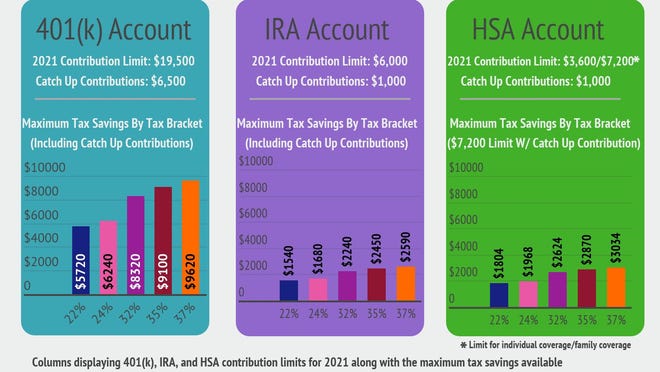
If you hate paying taxes (and most of us do), the IRS’ announcement that some couples may be able to sock away more than $10,000 next year in their health savings accounts should be music to your ears.
To keep up with the rampant inflation of the past few years, the IRS said last week it’s boosting by a record amount how much people can contribute to their HSAs next year. For 2024, the maximum HSA contribution will be $8,300 for a family and $4,150 for an individual, up from $7,750 and $3,850, respectively, in 2023. Participants age 55 and older can contribute an extra $1,000, which means an older married couple could sock away $10,300 a year, up from $9,750 this year. Typically, HSA caps are boosted each year by only about 1.5%, or $100 to $200, if at all.
HSAs, often overshadowed by the better-known 401(k) and individual retirement accounts, are seen as one of the best retirement savings accounts despite their name and being underutilized by most Americans, according to the Employee Benefit Research Institute.
“It’s a triple tax-free account,” said Zach Ungerott, senior wealth adviser at Hightower Wealth Advisors. “It’s one of the best tax breaks in the tax code. You never pay tax on any of that money, if used correctly.”
Pros and cons:A guide to health savings account (HSA) rules
Protect your assets: Best high-yield savings accounts of 2023
Compare benefits:What’s an FSA, HSA, 529? How they work and how to use them to cut taxes, build wealth.
What is an HSA and how do they work?
HSAs are intended to be tax-advantaged accounts to help people save for medical expenses, including deductibles, copayments, vision, dental, hearing, and even long-term care. To open one, you must have an HSA-qualified high-deductible health plan and not be enrolled in Medicare.
Contributions to an HSA are immediately tax-deductible, which means if a 55-year-old couple with a household income of $100,000 and a 22% tax rate contributes the maximum next year of $10,300, they’ll save $2,266 off the bat in taxes, said Jason Bornhorst, co-founder and chief executive of benefits platform First Dollar.
“Just those tax savings alone will pay for most people’s family vacation,” he said.
There’s more. Contributions can be invested and grow tax-free. Then, distributions at any age to pay for qualified medical expenses are tax-free.
That “triple tax advantage” to accountholders enables people to stretch money earmarked for health care expenses further than they otherwise could and are better than those from 401(k)s or IRAs, both traditional and Roth. Contributions in an employer-sponsored 401(k) and traditional IRA are taxed coming out while Roth IRA money is taxed going in.

Watch your taxes:Tax diversification can help you save. Here’s what to consider with your retirement funds.
Taxing:Your retirement savings could take a hit: What you need to know about taxes
How do you maximize an HSA?
To maximize an HSA, people need to contribute as much as they can, invest their contributions and limit withdrawals, if possible, to allow compound growth. Unfortunately, most people use their HSAs to pay for expenses, contribute little, and “relatively few” invest, the Employee Benefit Research Institute said. Only 12% of accountholders invested their HSAs in assets other than cash in 2021, it estimated.
- To demonstrate how important investing is, assume a 30-year-old contributes $8,300, the maximum family amount next year and invests it, with annual 5% growth and more yearly contributions. By 65 years old, the balance could be between $700,000 and $800,000 that can be used for qualified medical expenses, Ungerott said. That compares to about $350,000 if left in cash earning around 1% annually, he said.
Medical expenses in retirement can be substantial, with married couples potentially needing to save as much as $383,000, the Employee Benefit Research Institute said.
Preparing financially:Want to set yourself up for a secure retirement? Then make these 3 financial moves in your 40s.
Long-term health expenses:Time to have ‘the talk’: How seniors can avoid financial ruin by planning long-term health care now
HSA as an emergency fund, retirement piggy bank, IRA?
Savvy users also use the HSA as an emergency fund or piggy bank. Since there’s no timeline of when you must reimburse yourself, you can accumulate records of medical expenses and use them to withdraw HSA funds tax-free to pay yourself back whenever you need emergency cash or just to spend when you turn 65 years old, said Ryan Losi, executive vice president of accounting firm PIASCIK.
“Wealthy people will use it as a piggy bank, but you have to have cash flow” to pay medical expenses out of pocket for years and keep meticulous records, he said.
If you’re under 65 years, withdrawals for unqualified medical expenses are subject to a penalty and income tax. The penalty goes away when you turn 65 years old, which basically turns the HSA into an IRA if you don’t have qualified medical expenses, Bornhorst said.
“You just pay ordinary income tax on what you withdraw, like you would with an IRA,” he said.
Medora Lee is a money, markets, and personal finance reporter at USA TODAY. You can reach her at [email protected] and subscribe to our free Daily Money newsletter for personal finance tips and business news every Monday through Friday morning.






